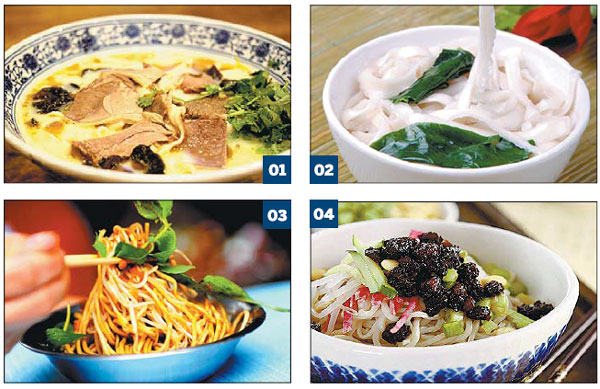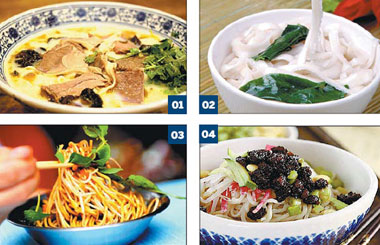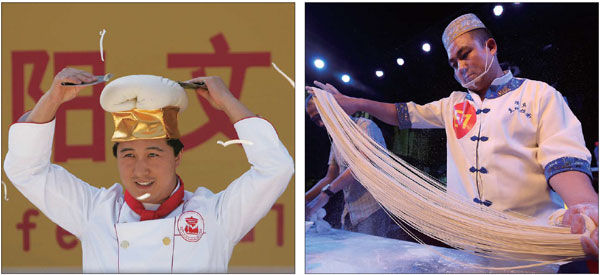Noodles - strands of history
Updated: 2016-01-08 07:56
By Pauline D Loh(China Daily Europe)
|
|||||||||||
|
|
"For the people, food is heaven" said historian Sima Qian of the Western Han Dynasty (206 BC - AD 24). Today, these words still ring true. The Chinese respect and passion for food is firmly entrenched in the cultural landscape, with a culinary scenery that reflects the vast geographical footprint of the world's most populous country. Pauline D Loh offers a view from the table.
The Central Plains is where it all began. The mighty Yellow River flows through this ancient cradle of Chinese civilization, and its annual floods slowly created the fertile loess plateau ideal for the cultivation of wheat and millet.
This was the genesis of the humble noodle - from vermicelli as fine as hair to a single strand that fills an entire soup bowl.
Noodles were eaten as far back as the Eastern Han Dynasty (AD 25-220) more than 1,900 years ago. The first primitive strings of dough have since evolved into many varieties.
In Zhengzhou, the main city of Henan province in Central China, thick chewy noodles are braised in a rich meat broth made mainly with mutton flavored with coriander and dried kelp. With its distinctive texture and taste, the braised noodles are listed among the five most popular noodle dishes in the country.
The artistry of noodle-making has become the culinary signature of nearby Shanxi, with a diversity of forms challenged only by the chefs' acrobatic abilities. Shanxi noodles - daoxiao mian - are hand cut and may range from those as thick as a belt to hair-like slivers.
Shanxi noodle chefs may also exhibit their skills by shaving perfect portions of dough directly into the boiling pot, often working too fast for the eye to follow. Or, they may knead the dough into a single strand, pulling it into a lone long noodle enough to make one hefty serving.
Because wheat is the main staple here, wives and mothers have had to use their wits and imagination to tempt their families into eating the same thing every day. They craft the dough into all sorts of interesting shapes, pinching them into cat's ears or little fishes, rolling them into tiny shells with a dexterous scrape of the thumb, and molding them into floral and animal shapes.
Only Italian pastas can challenge the variety, and every Chinese is convinced that it came about only because Marco Polo was ferrying noodle-making secrets home from China. As varied as the noodles are, the soups and broths that go into the making, the garnishes of meats and vegetables, and the seasonings all contribute to regional specialties and characteristics.
Even more colorful are the stories behind them.
Here are some of China's most popular noodle dishes:
1. Zhengzhou braised noodles
Henan province's best-known noodle dish has an illustrious pedigree that stretches back to the beginnings of the Tang Dynasty (AD 618-907).
According to legend, Li Shimin, the second emperor of the dynasty, was ill and weary while fleeing from his enemies. A poor farmer's wife gave him refuge and cooked him a bowl of noodles with the only meat she had - freshly slaughtered moose.
Sustained by the hot meal, he rallied, won the battle and established himself as emperor. He later rewarded the farmer's wife with riches and fame and the dish she created became an imperial staple, only made with mutton instead of moose.
2. Shanxi daoxiao (knife-shaved) noodles
It all began with a knife, or the lack of, and the infallible spirit of Han ingenuity.
About the 12th century, the Mongolians invaded China and began the Yuan Dynasty (1271-1368). The Han people chafed under Tartar rule and lived under strict restrictions, including the ownership of knives. Several households shared only one knife and noodle making became almost impossible.
One day, an enterprising cook decided to use a loose scrap of metal to shave the dough directly into the pot, and Shanxi noodle history was made.
The Mongols did not last long, and were ousted by a rebellion raised through secret messages pressed into sweet pastries called mooncakes. But that's another story.
3. Wuhan regan (dry-tossed) noodles
Serendipity played a part in the invention of Wuhan's famous tossed noodles in spicy sesame sauce.
The happy accident happened one day when a vendor found himself with too many portions of leftover noodles. Afraid that they would sour in the summer heat, he cooked them all and laid them out to cool on the table. He spilled some sesame oil over them and decided to use it as a dressing instead. The new noodles smelled so good that they quickly became the most popular order in the restaurant.
4 .Beijing zhajiang (meat sauce) noodles
This is probably the nearest Chinese equivalent to spaghetti Bolognese, although it is a uniquely Forbidden City invention. Freshly made noodles are cooked, quickly swished through cold water and served with a colorful assortment of thinly slivered vegetables topped with a ladle of dark, salty meat sauce. It is especially popular in summer.
The dish itself is a pretty sight with yellow noodles hidden beneath blanched Chinese cabbage, bean sprouts and julienne of pink watermelon radish, omelet strips and bean sprouts. It is also a cheap and healthy, tummy-filling dish perfectly suited to the poor. Traditionally, the meat sauce uses a sweet thick fermented bean paste from the imperial pickle masters Liubiju.
Next week: Food from the Forbidden City

Today's Top News
Going mobile
Wealth of options for China's super-rich
Man with knife shot dead outside Paris police station
Trading halted after shares fall 7% in opening minutes
China voices its 'resolute opposition' to DPRK test
Design exhibition to attract Chinese art works
Germans shaken by mass attacks on women
Concerns grow over Saudi-Iranian rising tensions
Hot Topics
Lunar probe , China growth forecasts, Emission rules get tougher, China seen through 'colored lens', International board,
Editor's Picks

|

|

|

|

|

|







